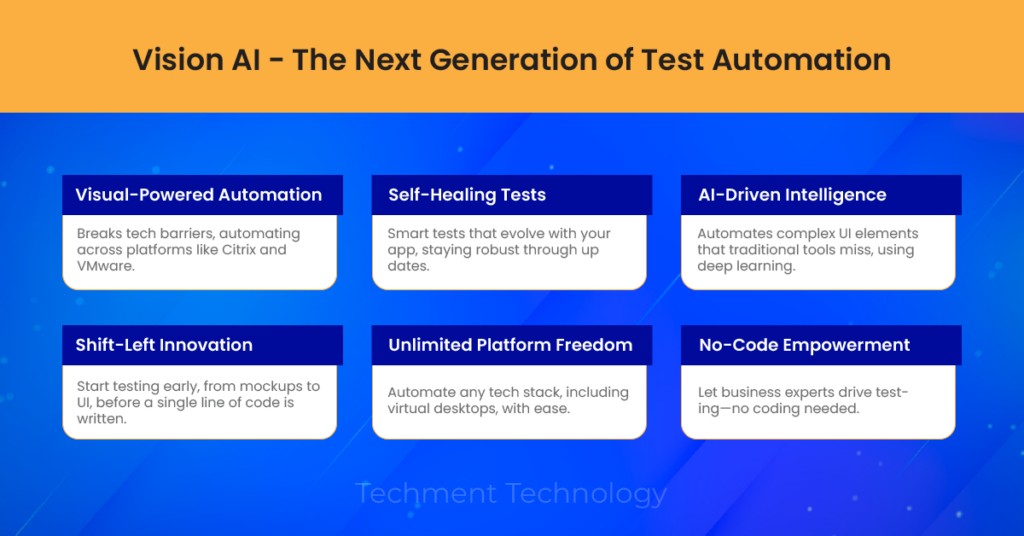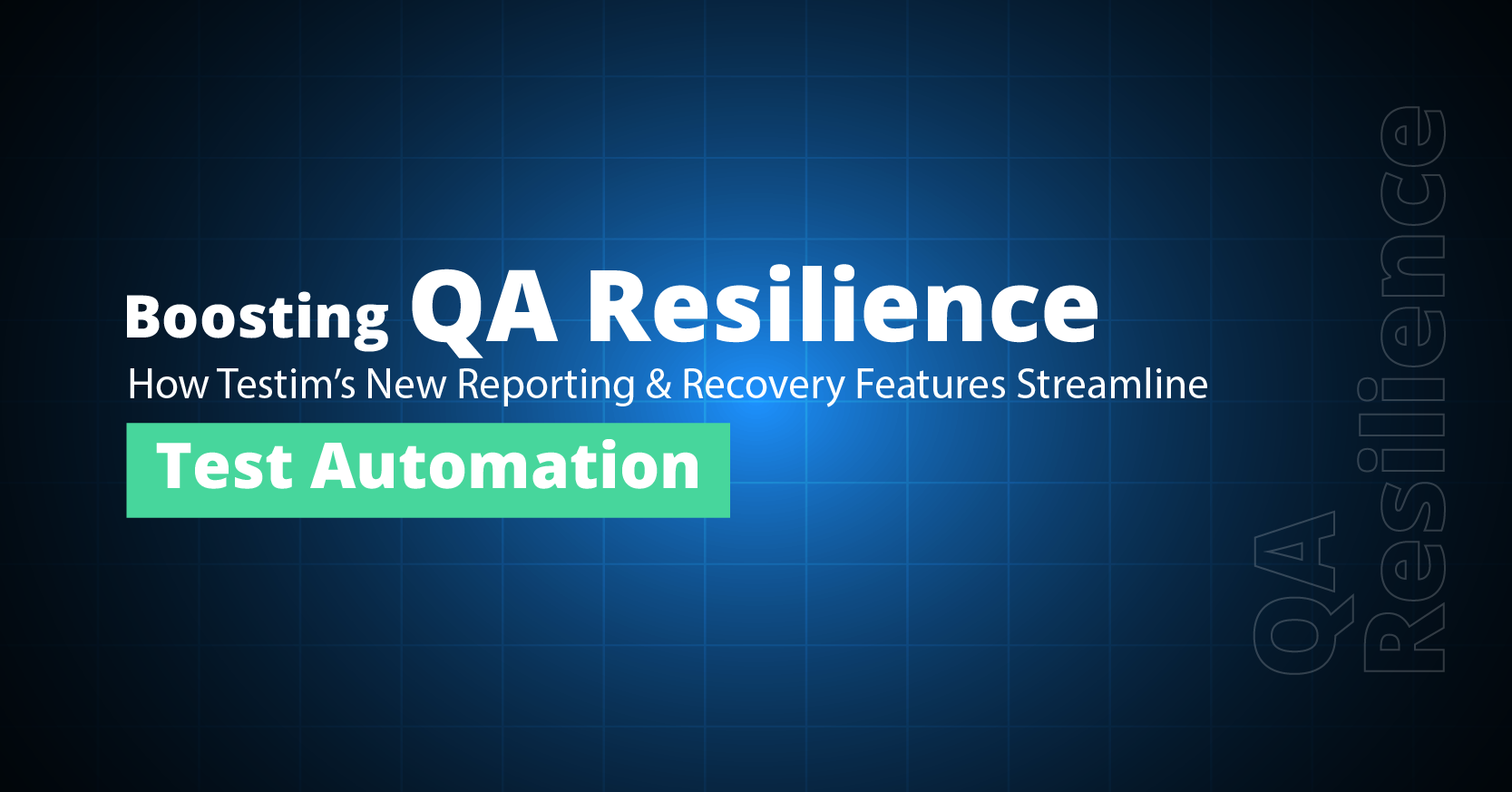As enterprises accelerate their digital transformation journeys, the need for efficient, reliable, and future-proof test automation becomes ever more pressing. Today’s digital landscape requires continuous innovation in application development, cloud transitions, and the modernization of existing apps. For businesses, the pressure is mounting on Agile and DevOps teams to quickly deliver high-quality software. This blog explores the key business challenges enterprises face, and how Tosca powered by Vision AI provides innovative solutions, and the use cases that illustrate its transformative capabilities.
In this blog, we will learn more about
- Why Test Automation Needs a Revolution: The Business Challenges
- Solution Overview: Tricentis Tosca and Vision AI
- Vision AI – The Next Generation of Test Automation
- Highlights of Vision AI
- Key Benefits Derived By Leveraging The Power of AI in Test Automation
- Real Business IMpact and Value For Testers and Testing
- Final Thoughts
Tricentis Tosca is a revolutionary solution in the world of test automation, addressing the growing complexity of applications and the demands of rapid development cycles. Built with AI-driven automation technology, Tosca helps enterprises tackle these challenges head-on, empowering them to automate user interfaces at the speed of innovation.
Why Test Automation Needs a Revolution: The Business Challenges
In the ever-evolving landscape of software development, the traditional testing methods that served us well in the past are now struggling to keep up with the changing times. While they have been the cornerstone of quality assurance for decades, the increasing complexity of applications, the rapid pace of development, and the rise of agile methodologies are exposing their limitations. Enterprises today face a wide array of challenges in their quest for faster, more efficient application delivery
Here are some of the key challenges with existing, traditional testing methods:
- Slow Feedback Cycles: The average time to resolve a software defect can extend up to 12-24 hours. This means that bugs can linger in the system for extended periods, leading to delays in releases and impacting customer satisfaction.
- High Costs: According to the “Cost of Software Bugs” report by Capgemini, the average cost of fixing a bug after deployment is 10 times higher than fixing it during development. This underlines the importance of catching errors early in the development cycle, which is often challenging with traditional testing methods.
- Limited Test Coverage: As per “State of Testing” report by Tricentis, only 20% of software development organizations have achieved high test coverage. This is primarily due to the limitations of traditional testing methods in addressing the complexity of modern applications, including mobile apps, cloud-based systems, and APIs.
- Inability to Keep Pace with Agile Development: Less than half of the organizations are able to effectively integrate testing into their agile development processes. Traditional testing methods often struggle to adapt to the iterative and collaborative nature of agile, resulting in bottlenecks and delays.
- Lack of Scalability and Automation: Only some organizations are actively using automation in their testing processes. Traditional testing methods rely heavily on manual processes, which are time-consuming, prone to errors, and difficult to scale.
- Testing Needs to Shift Left: Traditional UI test automation relies on a completed and stable UI.
- Technological Gaps: Extremely new, old, or specialized technologies often require extensive customization or remain unsupported.
- Maintenance Required : Even highly resilient tests need occasional attention and updates.
The challenges posed by traditional testing methods demand a shift towards more modern and innovative approaches. This includes embracing automation, adopting AI-powered testing tools, and integrating testing into the entire software development lifecycle. By addressing these challenges, organizations can ensure that their software is of the highest quality and delivered to market quickly and efficiently.
Tricentis Tosca, enhanced with Vision AI, is specifically designed to overcome these hurdles. By leveraging artificial intelligence, Tosca enables faster, smarter, and more resilient test automation, no matter how complex the technology or platform.
Solution Overview: Tricentis Tosca and Vision AI
Tricentis Tosca employs a risk-based testing strategy that streamlines testing efforts by highlighting potential risks to user experience and critical business processes. This approach enhances the advantages of automation. By focusing on risk, testing teams can identify and develop the most essential tests to mitigate business risks, significantly decreasing the number of required test cases while boosting confidence in release readiness. The resulting test suite is ideally designed for continuous execution within the delivery pipeline and can be easily updated as the application evolves—all achieved without the need for coding or scripting.
Tricentis Tosca, the market-leading model-based test automation tool, has long been a game-changer for businesses looking to automate tests without writing code. However, with the rapid development of new applications and the increasing demand for quicker testing cycles, Tricentis has taken automation a step further by introducing Vision AI.
Vision AI – The Next Generation of Test Automation
Vision AI is the next-generation, AI-driven test automation technology that enables teams to automate user interfaces regardless of the underlying technology. With machine learning, Vision AI “sees” and interacts with application interfaces just like a human user, making test automation future-proof, adaptable, and more efficient than ever before.Vision AI adapts intelligent object detection technology to detect controls and understand user interfaces.
From a tester’s perspective, you provide a natural language description of the actions to be performed, and the engine translates that into appropriate UI interactions. UI elements are identified based on their appearance rather than technical properties. If a UI element is redesigned or the application is re-implemented using new technology, it adapts seamlessly, just like a human would.

Highlights of Vision AI:
- Automation based on visual clues: It operates independently of the underlying platform or technology, even supporting remote desktop applications delivered via Citrix or VMware.
- Self-healing tests: Vision AI-driven automation adapts to changes in the application, ensuring tests remain resilient and usable even after significant technology updates or upgrades.
- AI-driven customization: Vision AI leverages deep learning to identify and automate complex controls that are hard to identify with traditional test automation tools.
- Shift-left testing: With Vision AI, teams can automate testing earlier in the development lifecycle, based on mockups or simple UI descriptions, before any code is written.
- Platform Independence: Automate any technology, including virtual desktop environments like Citrix and VMware.
- No-Code Testing: Business analysts and subject matter experts can easily contribute to testing without needing to write code.
Key Benefits Derived By Leveraging The Power of AI in Test Automation
Vision AI elevates Tosca’s capabilities by allowing automation to be more intuitive and aligned with human thinking. For the first time, testers can create automation from UI designs and mockups, shifting testing earlier in the development process and drastically reducing time to market. It also introduces a new category of AI-driven OCR, enabling fast and accurate understanding of user interfaces.
With Vision AI, organizations can derive the following key benefits:
- Test sooner: Shift testing left by automating based on mockups, ensuring test cases are ready as development begins.
- Test smarter: Vision AI adapts to application changes, reducing rework and allowing testing to evolve alongside the application.
- Test more: Vision AI supports all technologies, including virtual environments, enabling comprehensive test coverage across all platforms.
Real Business Impact and Value for Testers and Testing
Vision AI is more than a “test automation tool”—it’s a “test automation engine.” It integrates with core capabilities like test data management and test case design, supercharging existing tools. This added intelligence allows your automation to handle most UI changes, adapting as humans would. Vision AI is highly intelligent, having been trained on 9 million controls and over 12 million examples.
This might not be the first time you’ve heard about “AI in software testing.” Here’s how Vision AI adds real value to your testing practice:
- UI Automation Before UI Exists: Vision AI can build automation before the UI exists, using definitions like textual requirements, mockups, or whiteboard drawings, making in-sprint UI test automation achievable.
- Resilience Against App Modernization: Vision AI’s automation withstands application upgrades, even major ones like technology shifts or JavaScript library updates.
- Versatility Across Technologies: Vision AI works on any visual interface, automating across platforms like Citrix, Remote Desktop, outdated technologies (e.g., Silverlight), and new technologies (e.g., Flutter, Blazor).
- Ease of Use: Vision AI simplifies test automation to the point where anyone, regardless of technical expertise, can define automation tasks using natural language.
Final Thoughts
By harnessing the power of AI, Tosca with Vision AI delivers next-generation testing capabilities that help enterprises overcome their most pressing challenges. Whether it’s enabling earlier testing, increasing resilience, or supporting cross-platform automation, Tosca is designed to make test automation smarter, faster, and more efficient. Let Vision AI future-proof your testing process and unlock the potential of your applications.
It’s available to Tricentis Tosca users, but you don’t need Tosca to benefit from Vision AI. Our team at Techment can help you through this new era of test automation. Contact us to begin your journey with Vision AI. Your feedback is invaluable to us, so please share your insights and suggestions as you explore this groundbreaking technology.
Are you ready to revolutionize your test automation process with Tricentis Tosca and Vision AI? If so, you can start accelerating your application delivery, increasing test coverage, and future-proofing your automation today.
Learn more about Vision AI and how it can transform your testing by visiting Tricentis Tosca Vision AI.
 All Posts
All Posts
